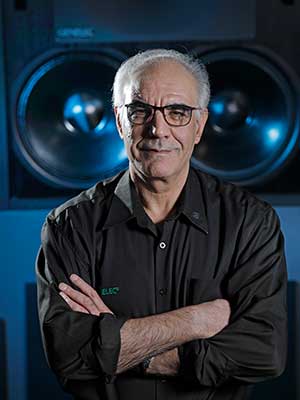New Board Members of Innohome Group Oy
We are pleased to announce that Mr Siamäk Naghian D. Sc. (Tech.) and Mr. Magnus Lengdell M.Sc, MBA have joined the Innohome Group Oy board in May 2022.
Both Siamäk and Magnus will bring on extensive experience in technology and international business. We at Innohome are very happy to get both onboard.


Genelec Oy has for over forty years developed the finest active loudspeakers and monitoring solutions for professional audio applications, worldwide. Designed and manufactured in Finland, the company’s products have received numerous amount of international awards throughout the years for their innovative technologies and design.
“Innohome offers the state-of-the-art safety technology solutions that make people lives more secure and safer at home and residential environments. The company’s high-quality and innovative safety technology solutions have already been proven by users around the world in demanding environments. The need for the standard safety and security solutions that people can trust will continue increasing in the future. I am very happy to be part of Innohome’s highly professional and committed team to support the company’s mission becoming a reality in the future.” states Siamäk.


AddSecure serves over 100 000 customers and partners around Europe with premium solutions for secure critical communications and data.
AddSecure has also specialized in providing end-to-end safety solutions for elderly living at home. The company’s annual turnover is around 160 M€ and it employs around 1000 employees.
”Innohome is an entreprenural driven high-quality product company, with great potential to expand in the residential safety and security markets. The customer need for increased safety in the residential homes is a global trend, which will open up new product and service opportunities for Innohome. I am exited to join the board of directors to grow the business as the market expand” says Magnus.
Innohome settles the IPR dispute
Innohome’s core, as also included in the company name, is in innovation and providing fire safety to homes. Since 2005 we have invented devices to prevent the kitchen fires and electrical fires at homes. The significant number of patents granted for our products throughout the years are there to protect our original ideas and product innovations.
Recently, we received another proof of the strength of our IPR as Norwegian Board of Appeal for Industrial Property Rights recognized the validity of Innohome patents in Norway. Norwegian Board of Appeal organization is an independent, court-like, body under the Ministry of Trade, Industry and Fisheries.
Innohome has been in litigation process against one of its competitors, Safera Oy, for several years in the market court of Helsinki Finland. Innohome is proud to announce, that the companies have reached a settlement this month and the dispute is over.
We happily continue the work to improve the fire safety of homes with our own products, as well as through licensing. Approximately 50 % of all home fires start in the kitchen and with Stove Guards most of them could be prevented.
Innohome accelerates its growth: a new Sales Director has started
Innohome keeps growing and to speed the growth even further we have employed a valuable new member to the company. This is to guarantee best possible interaction with Innohome and its larger product portfolio for our expanding customer network also in the future.
We are happy to announce M.Sc. (Tech.) Nina Autio to have started as a Sales Director at Innohome from 1st June 2021. Nina has a versatile background of btob-sales and sales management in international businesses. Her solid track record of leading sales growth in several different companies comes especially from the industrial chemical industry. Nina’s latest experience comes from Tekniseri, where she held a Sales Manager position before coming to Innohome.
Nina’s expertise of key account management supports Innohome’s strategy to operate in close collaboration with its distributors in different markets. Innohome’s management team also benefits from Nina’s expertise as she becomes an important member of it. Nina reports to CEO Juha Mört and leads the Innohome Sales Team.
We wish Nina warmly welcomed to Innohome!

Innohome's intellectual property
Innohome has been innovating and creating new technology since 2005. The patents granted throughout the years are the proof of original ideas and have led into creation of groundbreaking products and product features.
Another proof of the strength of our IPR is the decision from Norwegian Board of Appeal for Industrial Property Rights. The organization is an independent, court-like, body under the Ministry of Trade, Industry and Fisheries.
Here’s the link to the decision (in Norwegian): https://kfir.no/avgj%C3%B8relser/patent/safera-oy-innohome-oy
Why charge your EV at home from a charging station and not directly from a socket
Safe and fast home charging of an electric vehicle.

In the last few years, interest in electric vehicles has grown enormously. Different countries also aim to largely replace petrol and diesel operated vehicles with electric cars. Charging points are popping up all around the country at e.g. grocery stores and other similar locations. However, it is likely that electronic vehicles will primarily be charged at home in the future as well, since when people are home, their vehicles tend to sit unused for longer periods.
We listed some reasons why it pays off to use an actual charging station instead of a regular power socket – even at home.
SAFETY
Schuko sockets, which are generally used in outdoor installations and garages, are not designed for repeated, long-time use with the voltage levels that charging an electric car effectively demands. If damaged, they may overheat and cause a fire.
Other high-voltage appliances, such as stoves or electric sauna heaters, cannot be simply plugged into the socket, either. They require a fixed installation, where an electrician uses cables to connect the appliances permanently to an electric board, where they are protected by designated fuses.
Always ensure that the socket is safe for use, even if you only use it infrequently. Make sure that the socket is not oxidised or in otherwise poor condition. Check that the supply cable has been installed correctly (e.g. no heat insulation on top of the cable).



SPEED
With the help of a charging station, charging is significantly faster than using a normal household socket. It is not recommended to use sockets with over 8 ampere (A) current for over two hours charging. The charging current of the mobile charging device delivered with the car is therefore often limited based on official recommendations (e.g. in Finland to a maximum output current of 8 amperes).
The charging speed is always dependent on the vehicle’s charging capacity and the capacity of the grid being used (fuse size). A 22-kW charging station is guaranteed to deliver as much power as a car can accept and the electric installation allows.
All electric vehicles are usually delivered with two charging cables: one main charging cable and another for occational charging. The second one is intended for temporary, short-term use only. The first, however, is designed for faster, more efficient charging, and is used e.g. when charging the vehicle on a charging station at home.
EASE OF USE
A charging station is specifically designed for charging your electric car. It can handle repeated long-term charging, unlike a normal household socket. The charging station can easily withstand the repeated connecting and disconnecting of the charging cable. A normal household socket, on the other hand, is not designed for this, and can break if you even hang your travel charger on it for longer periods. The travel charging station should always be supported during charging so as not to strain the socket. With a normal charging device you don’t have to worry about this either.

